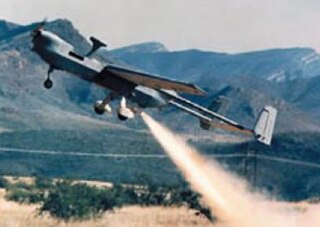
The IAI RQ-5 Hunter is an unmanned aerial vehicle (UAV) originally intended to serve as the United States Army's Short Range UAV system for division and corps commanders. It took off and landed on runways. It used a gimbaled EO/IR sensor to relay its video in real time via a second airborne Hunter over a C-band line-of-sight data link. The RQ-5 is based on the Hunter UAV that was developed by Israel Aerospace Industries.

An unmanned combat aerial vehicle (UCAV), also known as a combat drone, fighter drone or battlefield UAV, is an unmanned aerial vehicle (UAV) that is used for intelligence, surveillance, target acquisition, and reconnaissance and carries aircraft ordnance such as missiles, anti-tank guided missiles (ATGMs), and/or bombs in hardpoints for drone strikes. These drones are usually under real-time human control, with varying levels of autonomy. UCAVs are used for reconnaissance, attacking targets and returning to base; unlike kamikaze drones which are only made to explode on impact, or surveillance drones which are only for gathering intelligence.

The SAGEM Sperwer is an unmanned aerial vehicle manufactured by the French firm SAGEM. The aircraft is piloted remotely and can cruise at altitudes of over 16,000 feet for as long as five hours. It can send back images of targets up to 150 kilometers away from its ground control station.

Israel Aerospace Industries, is Israel's major aerospace and aviation manufacturer, producing aerial and astronautic systems for both military and civilian usage. It has 14,000 employees as of 2021. IAI is state-owned by the government of Israel.

The IAI Heron (Machatz-1) is a medium-altitude long-endurance unmanned aerial vehicle (UAV) developed by the Malat (UAV) division of Israel Aerospace Industries. It is capable of Medium Altitude Long Endurance (MALE) operations of up to 52 hours' duration at up to 10.5 km (35,000 ft). It has demonstrated 52 hours of continuous flight, but the effective operational maximal flight duration is less, according to payload and flight profile. An advanced version, the Heron TP, is also known as the IAI Eitan.
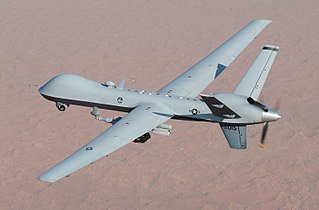
The General Atomics MQ-9 Reaper is an unmanned aerial vehicle capable of remotely controlled or autonomous flight operations, developed by General Atomics Aeronautical Systems (GA-ASI) primarily for the United States Air Force (USAF). The MQ-9 and other UAVs are referred to as Remotely Piloted Vehicles/Aircraft (RPV/RPA) by the USAF to indicate ground control by humans.

Ein Shemer Airfield is an Israeli Air Force (IAF) base in northern Israel, located approximately 6 km east of Hadera in the Haifa District, named after the nearby kibbutz Ein Shemer. It houses no fighter jets or helicopters but UAVs for testing and a defense missile battery with long-range radar.

The Elbit Hermes 450 is an Israeli medium-sized multi-payload unmanned aerial vehicle (UAV) designed for tactical long endurance missions. It has an endurance of over 20 hours, with a primary mission of reconnaissance, surveillance and communications relay. Payload options include electro-optical/infrared sensors, communications and electronic intelligence, synthetic-aperture radar/ground-moving target indication, electronic warfare, and hyperspectral sensors.

The Aeronautics Defense Dominator is an Israeli Medium-Altitude Long-Endurance (MALE) unmanned aerial vehicle (UAV) manufactured by Aeronautics Defense Systems. It is based on the Austrian Diamond DA42 Twin Star passenger aircraft. Dominator UAV executes intelligence, surveillance and reconnaissance (ISR) operations.

Aeronautics Defense Systems, doing business as Aeronautics, is an Israeli defense contractor headquartered in Yavne, Israel. The company primarily manufactures unmanned aerial vehicles for both military and civilian applications. Aeronautics’ senior management is made up of figures from Israel's defense, financial and political sectors. The company's CEO is Amos Mathan, who previously served as the CEO of Soltam Systems. The chairman of the board is Yedidia Yaari, a retired vice admiral who was the commander-in-chief of the Israeli Navy from 2000 to 2004 and the president of defense firm Rafael Advanced Defense Systems Ltd. from 2004 to 2015.

The IAI Searcher is a reconnaissance UAV developed in Israel in the 1980s. In the following decade, it replaced the IMI Mastiff and IAI Scout UAVs then in service with the Israeli Army.
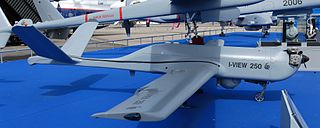
The IAI I-View is a small reconnaissance unmanned aerial vehicle developed in Israel in the early 21st century. Like other UAVs produced by IAI, it has fixed landing gear and an 18.6 kW (25 hp) piston engine. The Eye-View is also being promoted in civilian markets for forest fire warning, and in this form is appropriately known as the FireBird.
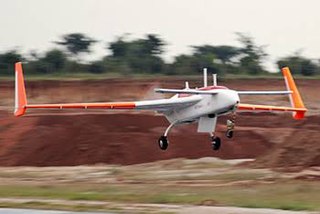
The DRDO Rustom is a family of medium-altitude long-endurance (MALE) unmanned air vehicle (UAV) being developed by the Defence Research and Development Organisation (DRDO) for the three services, Indian Army, Indian Navy and the Indian Air Force, of the Indian Armed Forces. Rustom is derived from the NAL's LCRA developed by a team under the leadership of late Professor Rustom Damania in the 1980s. The UAV will have structural changes and a new engine.
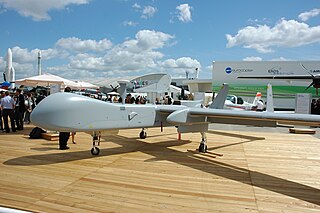
The EADS Harfang, formerly known as Système intérimaire de drone MALE is an unmanned aerial vehicle used by the French Air Force, supplementing the RQ-5 Hunter.

The Elbit Systems Hermes 900 Kochav ("Star") is an Israeli medium-size, multi-payload, medium-altitude long-endurance unmanned aerial vehicle (UAV) designed for tactical missions. It is a successor to the Hermes 450 series of drones, one of the most widely used military drones in the world.

The Israel Aerospace Industries Panther is a tilt-rotor unmanned aerial vehicle (UAV) produced by Israel Aircraft Industries in Israel.

210 "White Eagle" Squadron of the Israeli Air Force is an IAI Eitan squadron based at Tel Nof Airbase.

The Tactical Robotics Cormorant, formerly AirMule or Mule, Israel Defense Forces (IDF) codename Pereira, is a flying car unmanned aerial vehicle (UAV) built by Tactical Robotics Ltd., a subsidiary of designer Rafi Yoeli's Urban Aeronautics Ltd., in Yavne, Israel. It will be used in search and rescue operations where it is too dangerous or inaccessible for a helicopter, such as evacuating people from the upper stories of burning buildings, or delivering and extracting police and soldiers while very close to structures, narrow streets, or through holes into confined spaces.


















